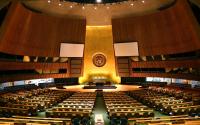11 September 2005Walter Pincus
The Pentagon has drafted a revised doctrine for the use of nuclear weapons that envisions commanders requesting presidential approval to use them to preempt an attack by a nation or a terrorist group using weapons of mass destruction. The draft also includes the option of using nuclear arms to destroy known enemy stockpiles of nuclear, biological or chemical weapons.
The document, written by the Pentagon's Joint Chiefs staff but not yet finally approved by Defense Secretary Donald H. Rumsfeld, would update rules and procedures governing use of nuclear weapons to reflect a preemption strategy first announced by the Bush White House in December 2002. The strategy was outlined in more detail at the time in classified national security directives.
At a White House briefing that year, a spokesman said the United States would "respond with overwhelming force" to the use of weapons of mass destruction against the United States, its forces or allies, and said "all options" would be available to the president.
The draft, dated March 15, would provide authoritative guidance for commanders to request presidential approval for using nuclear weapons, and represents the Pentagon's first attempt to revise procedures to reflect the Bush preemption doctrine. A previous version, completed in 1995 during the Clinton administration, contains no mention of using nuclear weapons preemptively or specifically against threats from weapons of mass destruction.
Titled "Doctrine for Joint Nuclear Operations" and written under the direction of Air Force Gen. Richard B. Myers, chairman of the Joint Chiefs of Staff, the draft document is unclassified and available on a Pentagon Web site. It is expected to be signed within a few weeks by Air Force Lt. Gen. Norton A. Schwartz, director of the Joint Staff, according to Navy Cmdr. Dawn Cutler, a public affairs officer in Myers's office. Meanwhile, the draft is going through final coordination with the military services, the combatant commanders, Pentagon legal authorities and Rumsfeld's office, Cutler said in a written statement.
A "summary of changes" included in the draft identifies differences from the 1995 doctrine, and says the new document "revises the discussion of nuclear weapons use across the range of military operations."
The first example for potential nuclear weapon use listed in the draft is against an enemy that is using "or intending to use WMD" against U.S. or allied, multinational military forces or civilian populations.
Another scenario for a possible nuclear preemptive strike is in case of an "imminent attack from adversary biological weapons that only effects from nuclear weapons can safely destroy."
That and other provisions in the document appear to refer to nuclear initiatives proposed by the administration that Congress has thus far declined to fully support.
Last year, for example, Congress refused to fund research toward development of nuclear weapons that could destroy biological or chemical weapons materials without dispersing them into the atmosphere.
The draft document also envisions the use of atomic weapons for "attacks on adversary installations including WMD, deep, hardened bunkers containing chemical or biological weapons."
But Congress last year halted funding of a study to determine the viability of the Robust Nuclear Earth Penetrator warhead (RNEP) -- commonly called the bunker buster -- that the Pentagon has said is needed to attack hardened, deeply buried weapons sites.
http://www.washingtonpost.com/wp-dyn/content/article/2005/09/10/AR2005091001053.html






